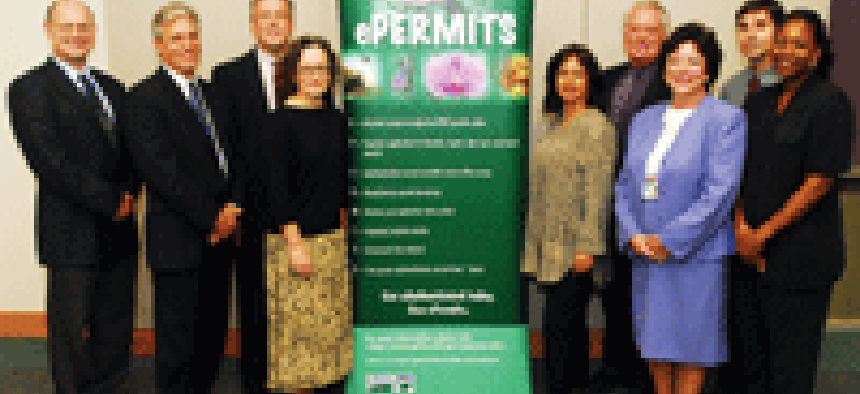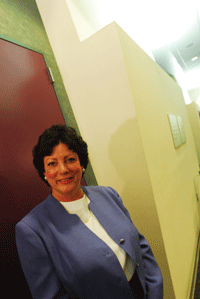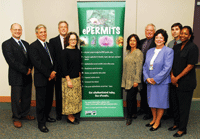Psst, want a great deal on some South American orchids? Canadian timber? African monkeys? Swedish biotechnology for research? The funds, shippers, receivers, means of transport'all the details'are negotiable except one: You're going to need a permit from the Agriculture Department's Animal and Plant Health Inspection Service.Getting that permit once took an average of four days of racing around town. But since April 3, you can get it in as little as one day without stirring from your chair.And that's just the beginning of the benefits to users, taxpayers and the department, said Alison Young, program manager for APHIS' Comprehensive El- ectronic Permitting System known as ePermits.Via the ePermits Web portal, registered users can apply for permits, pay for them online, check their status and receive the permits electronically, as well as on paper.'It's also improved oversight,' Young said. States and other departments can access the system online to verify that permits have been issued. Within APHIS, the transparency of the system and the ability to run queries have made a big difference, she said.Because system components consist of Web services built with open-source code and within a service-oriented architecture (SOA), any and all services are reusable by APHIS and other agencies, said Kevin O'Connor, account manager for ePermits contractor Science Applications International Corp. of San Diego.A Web service can be as simple as 'generate a letter,' O'Connor explained. Although Riverdale, Md.-based APHIS issues permits electronically via ePermits, 'we still have to issue a signed permit, and generating that paper permit and letter is a Web service.' The APHIS system has 100 types of letters, all customizable, and all reusable as Web services, he said.SAIC, which began working on the $12 million project in 2002, based ePermits on an application it had built for the Environmental Protection Agency, O'Connor said.That past performance was the most important element in selecting SAIC for the performance-based, fixed-price contract, Young said. 'EPA was happy with the solution, and we [could save time and money by having] SAIC tailor parts of that system for our use.'Neither the EPA application nor the original ePermits application was built on an SOA, O'Connor said. Today, most of the system has been converted. 'We're working on that as we speak,' he said.It would have been easier to have started with a service-oriented architecture, he said, 'but looking back, I'm not sure'for a lot of reasons'that we would have been ready for it then.'[IMGCAP(2)]But waiting until conditions were perfect was not an option, Young said. 'We looked at how long [the permit process] took and the performance metrics. We knew the number of permits was going to increase, but not our staff, so we had to do something.'Getting buy-in for the new system and the changes it would bring was crucial, Young and O'Connor agree.'What helped,' Young said, 'was a major customer interest in making it a success, a steering committee with the three major programs represented, an executive sponsor, a board of advisers, which included the head of acquisition and budget, the CIO's office sitting in on discussions from the beginning, and top-level management in the organization aware of what was going on and providing assistance and support.'Outreach sessions with users also were crucial in developing an application that would do the job, O'Connor said. The users 'loved it,' he said. 'They said, 'Omigod, you guys care what we think?' And when we asked for volunteers to test the application, all kinds of people raised their hands to participate.'Their input went into APHIS' ongoing business process re-engineering efforts. Using a workflow tool it had developed, SAIC modeled those processes and customized a workflow system for ePermits.Because that workflow system also is built using Web services, 'it lets us make changes to our workflow relatively quickly and without code changes,' Young said.While SAIC was integrating ePermits with Agriculture's Veterinary Services systems, the agency received results of an internal audit criticizing it for misplacing paperwork and asked SAIC to re-engineer its system, O'Connor said. 'Modeling its processes, and customizing and implementing the workflow system took less than two weeks'58 hours,' he said.One of the further changes to the system will be an expansion of its user base from 1,500 to as many as 10,000, including 3,000 Homeland Security Department users, Young said.Currently, Customs and Border Protection agents have read-only access to the system, O'Connor said, but when SAIC finishes building a bridge from the agency's Automated Commercial Environment to USDA's eAuthentication initiative, agents will get full access.A similar bridge will bring full access to staff at the Centers for Disease Control and Prevention.Another ePermits feature in development will let agents at ports scan a bar code on a shipping label to view permit information on a monitor. 'With paper permits, people can cross out expiration dates' and otherwise tamper with permits, O'Connor said.User feedback on ePermits has been good, and kudos on the system have been rolling in, Young said.The ePermits system has cut in half the time it takes to process applications to import plants and timber, according to Karen Brady, a permits specialist at USDA's Plant Protection and Quarantine.'It's nice to hear,' Young said, 'but we want to continue surveying our customers to be sure they stay happy.'Another USDA agency could soon reap the benefits of the APHIS system. 'The Food Safety and Inspection Service needs an automated import-export permit system that can interface with Customs,' O'Connor said. 'We're looking at that now.'
PROACTIVE: 'We knew the number of permits was going to increase, but not our staff, so we had to do something,' said Alison Young, APHIS program manager.
Rick Steele
Making it a success: Buy-in for the new ePermits system and the changes it would bring was crucial, said Alison Young (third from right), and outreach to users was a factor in getting it.
Rick Steele








